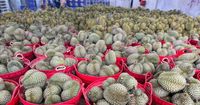In March 2025, Vietnam's fruit and vegetable exports showed a complex dynamic, recording nearly $421 million in earnings, representing a notable monthly increase but a troubling annual decrease. According to the Vietnam Fruit and Vegetable Association (VinaFruit), this figure is more than 34% higher than February's, yet down 10.5% when compared to March 2024. This pattern signals the third consecutive month of declines in export performance, contributing to a cumulative export value of around $1.1 billion for the first quarter of the year, which marks a 13.2% decrease from the same timeframe last year.
Current market analysis from VinaFruit indicates that the primary driver of these declines is the export of durians, a major product which is experiencing significant challenges. The Chinese market, which remains Vietnam's largest importer of fruits and vegetables, has implemented stricter import regulations. This includes detailed inspections for cadmium and other contaminants, particularly affecting the frozen durian shipments. Such measures have complicated the export process, leading to delays and heightened anxiety among local producers.
"The ongoing trade issues with durians are critical. Many businesses are hesitant to push their exports forward because of failed shipments returning from China for not meeting the required standards," said a representative from VinaFruit. This development raises concerns about achieving the ambitious export target of $8 billion for 2025, a goal that now seems increasingly unattainable under the current circumstances.
On a more optimistic note, the statistics from the first two months of 2025 revealed an increase in export volume to markets such as the United States, South Korea, and Japan—contrary to the recent trends. The rise in exports to these countries points to opportunities that Vietnamese businesses may need to capitalize on to diversify their market strategies.
As the local export landscape faces challenges, the import situation is markedly different. For March 2025, Vietnam's imports of fruits and vegetables reached $172 million, a 6.5% increase compared to the same month last year. Cumulatively, the country imported $578 million worth of produce during the first three months of the year, which reflects a 17% growth from the previous year.
The leading import markets for Vietnam include China, the U.S., Australia, and Chile, showcasing a robust demand for foreign fruits and vegetables that contrasts sharply with the declining export figures.
As reported in a recent meeting conducted on March 21, 2025, the Thanh Hoa Sub-Department of Quality, Processing, and Market Development collaborated with local authorities to train producers in digital transformation strategies. This initiative aims to refine the quality and marketing of Vietnamese agricultural products, which are crucial for enhancing competitiveness in both local and global markets.
Further analysis from VinaFruit highlights that acknowledging and addressing the barriers in production and trade processes is essential. Learning from challenges faced, especially with high-value products like frozen durians is crucial for future success.
The complexities surrounding Vietnamese fruit and vegetable exports signal a time of urgent re-evaluation. With simplified procedures and heightened standards, businesses must adapt by improving quality and finding alternative markets for their goods, particularly in regions showing growth, like the U.S. and Japan.
In conclusion, Vietnam's agricultural sector is at a pivotal moment, with the potential to recover and thrive if it can navigate the obstacles set by strict import standards in key markets. Strengthening export strategies could revitalize the industry's growth and help meet, if not surpass, the projected goals for future export value.






